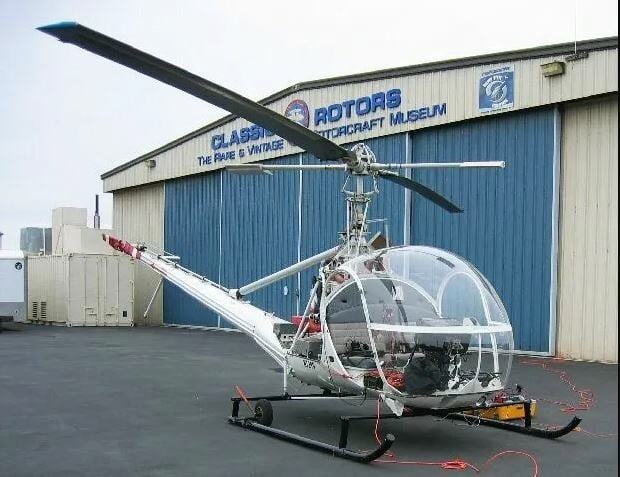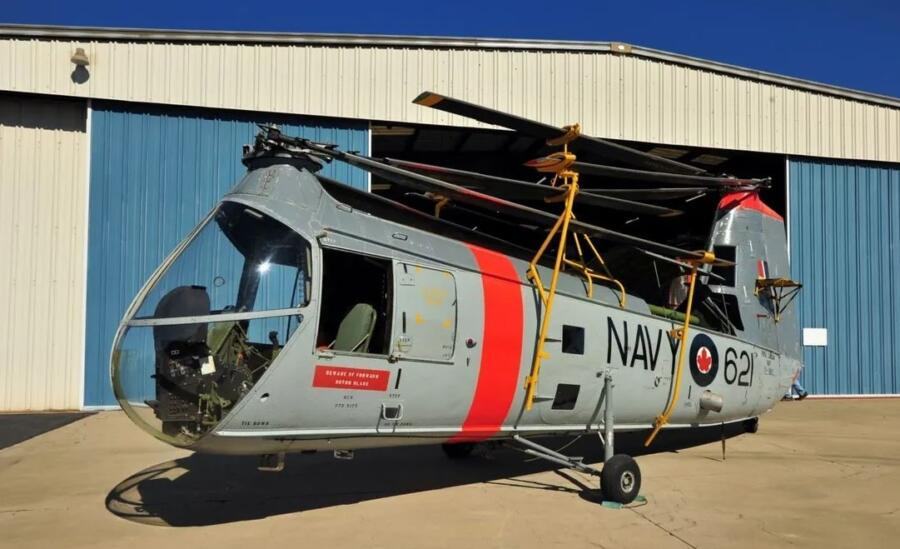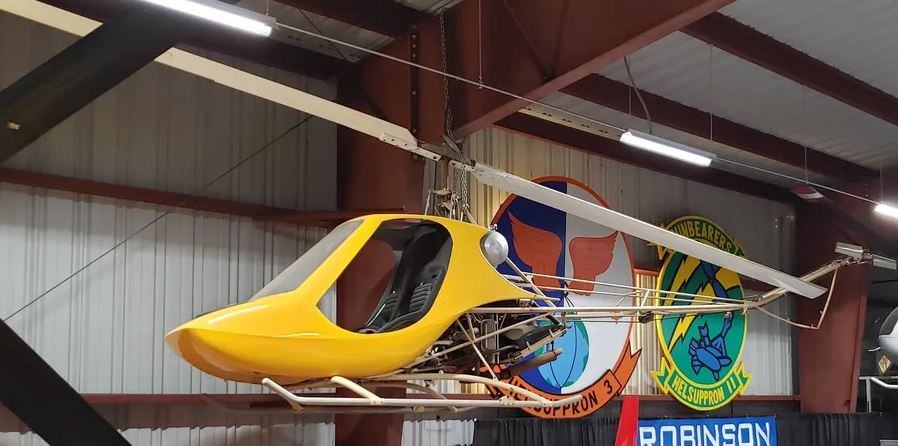Classic Rotors is a unique aircraft museum in Ramona, California. One-of-a-kind refers both to the museum and the helicopters. The museum is dedicated to rescuing one-of-a-kind and unique historically significant helicopters. The all-volunteer museum staff brings these historic aircraft back to flying condition and then flies them. They have several one-of-a-kind helicopters, and some are the only flight-capable helicopter models of these historic helicopters in the world.
Image at the top
The photo at the top of this page is a newly refurbished H-46 Seaknight. It came from the Marines at Cherry Point. The original H-46 is nearly as old as I am. The H-46 is also one of the few aircraft I have flown at Classic Rotors, only for about one hour. During that time, I learned that flying is easy. But, as far as I am concerned, it is nearly impossible to taxi on the ground. The only way I could roll the aircraft across the ground was to lift the front wheel into the air and then roll the rear wheels behind me.

The H-46 is one of only a few aircraft on display that was flying when the Museum received it. The military newly refurbished it right before they gave it to the museum.
Classic Rotors
Classic Rotors is not just a helicopter museum. Instead, the common theme is that all the aircraft in the museum have a rotor system that enables or, more accurately, creates lift, which allows flight. The museum includes non-helicopters that are held in the air with rotating wings.

Most of the rotorcraft in the museum are standard configurations, either a primary rotor and tail rotor combination or two main lifting rotors. Other aircraft are unique, including some that only have one main rotor and no tail rotor and even two aircraft that creates thrust by either burning fuel at the tip of the rotor or exhausting pressurized air from the tip of the rotor. Classic Rotors has several helicopter models with two rotors on a single mast and even one with intermeshing rotors. In addition to these unique helicopters, they have helicopter prototypes that never successfully flew and even rotorcraft that were not helicopters.


Classic Rotors has some models even the Smithsonian Air and Space Museum doesn’t have. Some aircraft are the only flying aircraft of this type; others are the only aircraft ever created of a specific type. The staff at Classic Rotors often restores these historic aircraft to flying condition (assuming they ever few in the first place).

Classic Rotors has multiple aircraft (including some pictured in this blog) that I never knew existed. Some of these historic and unique aircraft were one of a kind. Some were failures and never achieved flight, others are the only left remaining aircraft of many produced.
Mark DiCiero
Mark DiCiero didn’t start as a collector. He started as a dreamer who thought he could build a helicopter in his garage and then learn how to fly it without any instruction in his backyard. The amazing thing is that he accomplished both of these nearly impossible tasks.
Like the early helicopter pioneers, he built a helicopter and learned to fly it without instruction. Mark didn’t invent his helicopter but purchased it as a kit. Over 2500 kits were sold, and Mark was among the few to achieve flight. After finishing the kit, he may have been the only non-helicopter pilot to teach himself to fly other than the early helicopter pioneers.

Any helicopter pilot will tell you that the most challenging part of flying a helicopter is learning how to hover. Mark learned to hover by reading a book and carefully applying the steps from the instruction book. The story goes that he demonstrated how to slide the aircraft along the ground to some curious friends. After the demonstration, his friends told him he was in the air, not sliding on the ground. This is amazing because I know from all my training, and I am sure that Mark knows this as well, that flying while in contact with the ground is one of the most dangerous things you can do with a helicopter.

After building his helicopter, Mark took it to the national fly-in of experimental aircraft. Sometime after, he started a helicopter rescue collection and rescued multiple aircraft. Instead of using helicopters to rescue people, Mark began to rescue helicopters. Mark’s volunteers then spent countless hours restoring these vintage aircraft to flying conditions. Only four aircraft in this collection were flyable when the museum picked them up. He rescued some aircraft in a scrapyard, like the Piasecki HRP (picture above). It was being sold for metal scrap.
The Classic Rotors Helicopter Museum
The Classic Rotors Helicopter Museum has more aircraft (on display) than it has display space. I only visited the main hangar. There, they have aircraft stuffed into an aircraft hangar, with most aircraft overlapping other aircraft. The main hangar has aircraft on display that cannot be photographed individually.

At Classic Rotors, they know they need more space—lots of space. This isn’t a critique but rather a fact. Many one-of-a-kind, priceless aircraft are squeezed into this museum. Many other aircraft are not on display because there is no room to display them.
Restoration
A big part of what happens at Classic Rotors is behind the scenes. You can’t put it directly on display when you pick up an aircraft from a salvage yard. Sometimes, the helicopter looks like a collection of unrelated parts, or corrosion on these old parts has eaten away all the metal.

Many of the oldest aircraft rescued by Classic Rotors were fabric-covered. The fabric turned to dust long ago, and only threads remain. Restoration is a slow process, and I don’t really understand how they do it. Perhaps on my return visit, I can spend lots more time and make some visits to see restoration in process.
Ramona
The hangers are located at the Ramona Airport, about 35 miles northeast of San Diego. Classic Rotors also knows that if you are not looking for it (at the airport) and really intend to find it, then you are not going to find it. The location has almost no drive-by traffic.

Notice the sign on the wall above the helicopters. The Aerolift was a rotor-powered balloon. The sign came from Tillamook, Oregon. We visited the Tillamook Air Museum last fall and saw pictures of the Aerolift. I wonder if they want their sign back.
To visit Classic Rotors, you first have to find your way to Ramona. That will be the hard part. The airport is to the north of Main Street. The easy way (to describe the route) will be to go north of Main Street on Montecito Road. Montecito Road will curve around to the west, and once you get to the airport area, Classic Rotors will be on the left side of Montecito Road.
Video
It should be evident that I had nothing to do with making this video about historic helicopters. But watching it will give you an insight into the kind of aircraft that Classic Rotors is trying to find and restore. Many of the aircraft in this video are only found on film, and others are in the Smithsonian Air and Space Museum.
This even older video from 1943 describes Mark’s vision of building a helicopter and using it for his everyday chores.
Reflections
If you happen to know about any old helicopters or even old helicopter parts, make sure to give Classic Rotors a call. Hopefully, they can rescue them. Most of these old helicopters are lost to history and will never be found, but just like old cars, some may be hidden away in the back of a barn somewhere, waiting for Classic Rotors to rescue them.
Photo Credits
Nearly all the photos in this blog post were taken by Classic Rotors, not by me. The museum is too tightly packed for me to take pictures of individual aircraft.
Similar Collections
Please subscribe and join us on our journey.
We will add you to our email list and send you updates once a week. Here is a link. Subscribe
About our links
Our blog income is zero, allowing us to be independent and tell the truth. We do not get income or commissions. No, we don’t make paid endorsements. We don’t make recommendations; instead, we will tell you what we like (or dislike). The links are only provided as a quick reference to help our readers.
Links
About Comments
We love seeing your comments, but they are not automatic. I get about twenty spam comments daily, so I don’t have automatic comments. I read and then publish every comment personally to protect the blog and keep it on-topic. So this means that you will not see your comment right after you hit submit. Sorry for the delay in publishing your comments. Please know that we would love to hear from you.


I am fighting with my website and lots of things are out of wack.
If you are new and want to subscribe please leave a comment.
Thanks, Scott
Classic Rotors was extremely interesting. Thanks, Scott
I would have found this interesting even if I didn’t know you. But knowing you greatly enhanced its value to me. Thank you!
So interesting. I always check the location of your posts to see if we will be in that area. Unfortunately I won’t be able to take John to this cool museum this time around.
Safe travels!
Hey there
I also lived through a computer crash, however, I didn’t fair as well. I lost years’ worth of pictures, I had saved.
The guy who taught himself to fly reminds me of the Flight Museum we toured in Dallas last weekend.
They titled the sign,
The “Father of U.S. Military Aviation” Benjamin Foulois was one of the first Army officers to pilot the original military airplane purchased from the Wright Brothers in 1909. He taught himself to fly after receiving flying instructions by mail from the Wrights. He flew with Orville Wright and soloed on March 2, 1910. At Fort Sam Houston, in San Antonio, Texas, along with eight crewmen and Military Aircraft No.1, he established the Army “Air Force”. He was the only pilot, navigator, instructor, and observer in the Army’s air service from November 1909 to April 1911.
Thank you for including me on your mailing list, I certainly enjoy it.
Pingback: Astronaut Bill Anders amazing Heritage Flight Museum - FoxRVTravel
Pingback: Top Secret Titan Missile Museum - FoxRVTravel